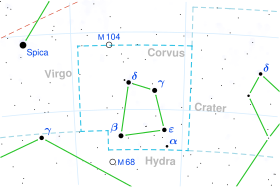Eta Corvi
| Observation data Epoch J2000.0 Equinox J2000.0 (ICRS) |
|
|---|---|
| Constellation | Corvus |
| Right ascension | 12h 32m 04.22653s |
| Declination | −16° 11′ 45.6165″ |
| Apparent magnitude (V) | 4.29 - 4.32 |
| Characteristics | |
| Spectral type | F2 V |
| U−B color index | +0.00 |
| B−V color index | +0.38 |
| R−I color index | +0.18 |
| Variable type | Suspected |
| Astrometry | |
| Radial velocity (Rv) | −2.80 ± 1.5 km/s |
| Proper motion (μ) |
RA: −425.17 mas/yr Dec.: −57.23 mas/yr |
| Parallax (π) | 54.70 ± 0.17mas |
| Distance | 59.6 ± 0.2 ly (18.28 ± 0.06 pc) |
| Absolute magnitude (MV) | 2.99 |
| Details | |
| Mass | 1.43 ± 0.05 M☉ |
| Radius | 1.2 R☉ |
| Temperature | 6700 K |
| Metallicity | [Fe/H] = −0.03 |
| Rotational velocity (v sin i) | 68 ± 2 km/s |
| Age |
1.5+0.2 −0.4 Gyr |
| Other designations | |
| Database references | |
| SIMBAD | data |
| ARICNS | data |
Eta Corvi (Eta Crv, η Corvi, η Crv) is an F-type main-sequence star, the sixth-brightest star in the constellation of Corvus. Two debris disks have been detected orbiting this star, one at ~150 AU, and a warmer one within a few astronomical units (AU).
Eta Corvi is only about 30% of the Sun's age. The concentration of iron and other heavy elements in its atmosphere is only about 93% that of the Sun's. The projected rotational velocity at the star's equator (v sin i) is 68 km/s - more than 30 times faster than that for the Sun. A yellow-white main sequence star of spectral type F2V, it has an estimated surface temperature of 6950 K. It is 1.52 times as massive as the Sun and is 4.87 times as luminous. It is 59 light-years distant from the Solar System.
The IRAS satellite detected an excess of infrared radiation from this star, beyond what would normally be expected for a stellar object of this class. Observations in the submillimetre band confirmed the presence of excess dust in orbit around the star having about 60% of the mass of the Moon and a temperature of 80 K. The data indicated a debris disk with an estimated maximum radius of 180 AU from the star, or 180 times the separation of Earth and the Sun. (Compare to the Kuiper belt, which extends out to 55 AU from the Sun.)
Recent submillimeter observations confirm the presence of an outer flat, circumstellar disk of debris with an outer radius of 150 AU. It is oriented at an inclination to the line of sight from the Earth. Most of the inner 100 AU of the disk is relatively free of material, which suggests it was cleared away by a planetary system. In addition, infrared radiation which appears to be from an inner, hotter, debris disk within 3.5 AU of the star has been observed.
...
Wikipedia

